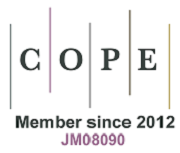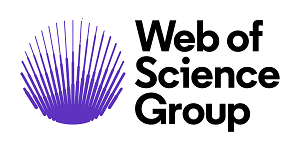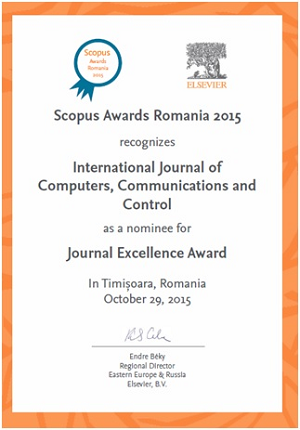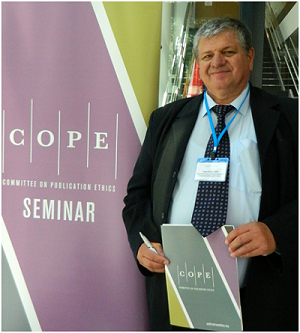Manufacturing Process Monitoring in Terms of Energy Management Improving
Keywords:
intelligent decision-making, LoRaWAN communication protocol, wireless sensor networkAbstract
Seeking out new technologies and deploying them for competitive advantage is a key priority for any company. In this context, Internet of Things (IoT) promise to change the way we live and work. IoT could help us in overtaking the top global challenges, as energy management, agriculture and food security, environment and natural resources security, etc., but to achieve this vision, "things" need to sense their environment and share this information among them as well as with us to offer intelligent decision-making. Nowadays, IoT become even more interesting due to the existence of Low Power Wide Area (LPWA) networks. LPWA is a key component of a wider IoT technology wave. In this paper, a LoRaWAN based solution is presented, for manufacturing process monitoring, in order to improve energy management in plants. The authors present a minimally invasive device, with which many product manufacturing data can be obtained for analysis and further improvements. This paper is an extended variant of [14].References
Augustin, A.; Yi, J.; Clausen, T.; Townsley, W.M. (2016). A Study of LoRa: Long Range & Low Power Networks for the Internet of Things, Journal of Sensors, 16(9), 1-18, 2016. https://doi.org/10.3390/s16091466
Avotins, A.; Senfelds, A.; Apse-Apsitis P.; Podgornovs, A. (2017). IoT solution approach for energy consumption reduction in buildings: Part 1. Existing situation and problems regarding electrical consumption, Proceeding of the 58th International Scientific Conference on Power and Electrical Engineering of Riga Technical University (RTUCON), 31-36, 2017. https://doi.org/10.1109/RTUCON.2017.8124847
Avotins, A.; Podgornovs, A.; Senfelds, A.; Vegeris M. (2018). IoT Solution Approach for Energy Consumption Reduction in Buildings: part 2. Measurement Setup and Practical Data Analysis, Proceedings of the17th International Scientific Conference on Engineering for Rural Developmen, 923-929, 2018. https://doi.org/10.22616/ERDev2018.17.N375
Berthelsen, E.; Morrish, J. (2015). Forecasting the internet of things revenue opportunity, Tech. Rep., 2015.
Cattani, M.; Boano, C.A.; Romer, K. (2017). An Experimental Evaluation of the Reliability of LoRa Long-Range Low-Power Wireless Communication, Journal of Sensor and Actuator Networks, 6(2), 1-18, 2017. https://doi.org/10.3390/jsan6020007
Garetti, M.; Taisch, M. (2012). Sustainable manufacturing: trends and research challenges, Journal ofProdustion Planning & Control, 23(2), 83-104, 2012. ] https://doi.org/10.1080/09537287.2011.591619
Kharel, J.; Shin, S. Y. (2017). Smart Health Monitoring System of Employee for Smart Factory, Proceedings of Symposium of the Korean Institute of communications and Information Sciences, 1-6, 2017.
Nokia (2016). LTE evolution for IoT connectivity, Tech. Rep., 2016.
Petajajarvi, J.; Mikhaylov, K.; Roivainen, A.; Hanninen, T.; Pettissalo M. (2015). On the coverage of LPWANs: range evaluation and channel attenuation model for lora technology, Proceedings of the 14th International Conference on ITS Telecommunications (ITST), 55- 59, 2015. https://doi.org/10.1109/ITST.2015.7377400
Neumann, P.; Montavont, J.; NoATl, T. (2016). Indoor Deployment of Low-Power Wide Area Networks (LPWAN): a LoRaWAN case study, Proceedings of the 2th International Conference on Wireless and Mobile Computing, Networking and Communications (WiMob), 54-58, 2016. https://doi.org/10.1109/WiMOB.2016.7763213
Petjjrvi, J.; Mikhaylov, K.; Hmlinen, M.; Iinatti, J. (2016). Evaluation of LoRa LPWAN technology for remote health and wellbeing monitoring, Proceedings of the 10th International Symposium on Medical Information and Communication Technology (ISMICT), 1-5, 2016. https://doi.org/10.1109/ISMICT.2016.7498898
Rizzi, M.; Ferrari, P.; Flammini, A.; Sisinni, E. (2017). Evaluation of the IoT LoRaWAN Solution for Distributed Measurement Applications, Journal of Instrumentation and Measurement, 66(12), 1-18, 2017. https://doi.org/10.1109/TIM.2017.2746378
Raza, U.; Kulkarni, P.; Sooriyabandara M. (2017). Low Power Wide Area Networks: An Overview, Journal of Communications Surveys & Tutorials, 19(2), 855-873, 2017. https://doi.org/10.1109/COMST.2017.2652320
Simo, A.; Barbulescu C.; Kilyeni, S.; Dragos, C. (2018). LoRa based Energy Efficiency Improving in Manufacturing Processesn; Proceeding of the 7th International Conference on Computers Communications and Control (ICCCC), 156-161, 2018. https://doi.org/10.1109/ICCCC.2018.8390453
Shrouf, F.; Miragliotta, G. (2015). Energy management based on Internet of Things: practices and framework for adoption in production management, Journal of Cleaner Production, 100, 235-246, 2015. https://doi.org/10.1016/j.jclepro.2015.03.055
Weinert, N.; Chiotellis, S.; Seliger G. (2011). Methodology for planning and operating energy-efficient production systems, CIRP Annals, 60(1), 41-44, 2011. https://doi.org/10.1016/j.cirp.2011.03.015
Xiong, X.; Zheng, K.; Xu, R.; Xiang, W.; Chatzimisios, P. (2015). Low power wide area machine-to-machine networks: key techniques and prototype, IEEE Communications Magazine, 53(9), 64-71, 2015. https://doi.org/10.1109/MCOM.2015.7263374
Published
Issue
Section
License
ONLINE OPEN ACCES: Acces to full text of each article and each issue are allowed for free in respect of Attribution-NonCommercial 4.0 International (CC BY-NC 4.0.
You are free to:
-Share: copy and redistribute the material in any medium or format;
-Adapt: remix, transform, and build upon the material.
The licensor cannot revoke these freedoms as long as you follow the license terms.
DISCLAIMER: The author(s) of each article appearing in International Journal of Computers Communications & Control is/are solely responsible for the content thereof; the publication of an article shall not constitute or be deemed to constitute any representation by the Editors or Agora University Press that the data presented therein are original, correct or sufficient to support the conclusions reached or that the experiment design or methodology is adequate.







